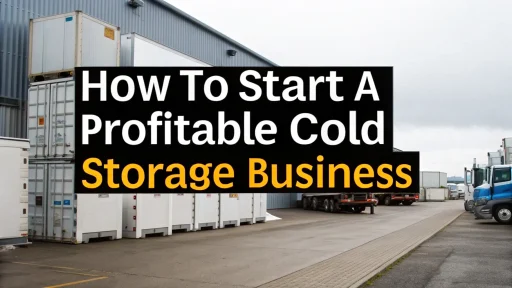In India’s rapidly changing economy, the cold storage business has become a critical necessity for agriculture, pharmaceutical, and e-commerce industries. With the right infrastructure, this sector offers high-impact opportunities for new businesses and diversification for existing ones. A deep understanding of the market, operating processes, and the ecosystem is key to growing a profitable cold storage facility.
Key Functions of Cold Storage Businesses
All cold storage businesses are built on two key functions: a temperature-controlled environment and a cooling system. These ensure quality control and easy storage of goods with a major focus on temperature. The quality and shelf life of goods like meat, fish, nuts, pharmaceuticals, frozen snacks, and certain chemicals are critical.
Types of Cold Storage Facilities
Most facilities operate in one of three formats:
- Private Storage Units: Owned by food processing companies or pharmaceutical manufacturers for internal use.
- Public/Third-Party Warehouses: Space is rented out to traders, exporters, wholesalers, or other businesses.
- Flexible Cold Storage: These emerging facilities can hold and store a combination of items at specific temperatures in multiple temperature-controlled compartments, increasing profit and flexibility for operators. These facilities incorporate mixed B2B and B2C strategies to serve both business and consumer clients.
Related: A Guide about Cold Storage Market Analysis
Market Demand and Growth of the Sector
India’s cold storage sector is growing rapidly due to post-harvest losses, increased consumption of perishables, and growing logistics in the pharmaceutical sector. India generates over 300 million metric tons of perishable food every year. However, a large amount of this food goes to waste because of inadequate cold chain infrastructure. This underlines the enormous untapped potential and demonstrates the need for cold storage in both rural and urban India.
The Indian government’s significant spending in agri-infrastructure and food processing industries, along with other countries’ growing interest in Indian pharmaceutical products and seafood exports, forecasts the cold storage market to reach ₹ 1,500 billion by 2027, growing at a CAGR of 14.8% from 2022 to 2027.
The rise of online grocery stores, Q-commerce companies, and international pharmaceutical firms has increased dependence on last-mile cold chains. Existing concerns about climate change, along with increased food inflation, have made it essential for supply chains to cut down on waste, making cold storage a necessity.
Importance Across Sectors
- Agriculture: Essential, considering India is the largest producer of milk and the second-largest producer of fruits and vegetables. Efficient cold storage facilities are critical in decreasing wastage and increasing farmer earnings.
The dairy sector utilizes bulk milk chillers and refrigerated stores for maintaining the freshness of milk and other products like cheese and curd. - Seafood and Meat Export: Critical for maintaining international quality standards, reducing shipment rejections, and increasing the shelf life of goods. The rising purchasing power and shift to urban settings have increased the demand for frozen foods, strengthening the FMCG cold chain.
- Pharmaceuticals: The growing demand for vaccines and the production of cold chain active pharmaceutical ingredients (APIs) and biologics is increasing the demand for pharmaceutical cold storage maintained under rigid temperature controls of 2°C to 8°C (or sub-zero).
- E-commerce: The growth of e-commerce and pharmacy home delivery models requires hybrid cold storage that integrates storage with refrigeration and the delivery system in one place.
For more information, check out Cold Storage Handbook
Establishing a Cold Storage Business: Key Considerations
Establishing a cold storage business requires a comprehensive approach, including building a cold storage facility, specialized design, appropriate equipment, and management systems.
Location
Identify a location close to production clusters (farming, fishing, dairies, food processing, and pharmaceutical parks) that is also served by highways, railway terminals, and ports for quick and cheap distribution. Reliable electricity, water, and skilled workers are critical for uninterrupted facility operation.
Design and Structure
The structure must be thoroughly insulated using high-quality materials like PUF (Polyurethane Foam) panels to prevent heat transfer and maintain internal temperatures efficiently. Pre-engineered buildings (PEBs) have gained traction for their ease of installation and durability.
Refrigeration System
Operators can choose between ammonia-based and Freon-based cooling systems depending on the specific product, storage volume, and energy needs. Standard setups include compressors, condensers, evaporators, and cooling coils to uniformly maintain temperatures between +20°C and -40°C across chambers. Humidity control units, circulation systems, and automatic door locks are also important for food safety.
Technology and Systems
Modern cold storage blend systems for IoT (Internet of Things) temperature and humidity tracking. IoT systems for energy management help manage compressor cycles, which is critical in such facilities due to high power bills. Fire systems and emergency power backups, often diesel generators or integrated solar, provide additional security and reliability.
Operations and Management
Running the facility requires staff training for handling inventory control, stacking, and equipment maintenance. Safety compliance, hygiene, and real-time product monitoring are crucial parts of daily management.
Related: Cold Chain Temperature Controlled Supply Chain
Categorization of Cold Storage Facilities
Cold storage facilities can be classified according to the type of goods stored and the temperature zones of operation.
- Single-Commodity Cold Storages: Focused on specific items like potatoes (stored at 2°C to 4°C). Dedicated storage facilities also exist for apples, onions, and dairy products, and are common in the higher producing states of Himachal Pradesh, Maharashtra, and Punjab.
- Multi-Commodity Cold Storages: More flexible, enabling storage of several different product types in separate chambers. These are best for retailers, wholesalers, or exporters who have diverse inventories for the different seasons of the year.
- Controlled Atmosphere (CA) Cold Storages: More sophisticated, controlling temperature and changing levels of oxygen, carbon dioxide, and nitrogen to retard ripening or spoiling of fruits like apples and pears.
- Pharmaceutical Cold Rooms: Built to rigid rules for monitoring the storage of vaccines and APIs, providing 24/7 surveillance, a sterile environment, and compliance with WHO-GMP.
Location Considerations for Market Entry and Business Expansion
The positioning of your cold storage facility will greatly impact your business’s growth potential and sustainability.
- Agricultural Cold Storage: Regions such as Nashik for grapes, Lucknow for potatoes, Ludhiana for milk, and Kolkata for fish are advantageous because of high agricultural yield and consistent demand throughout the year. Coastal cities like Chennai, Kochi, and Visakhapatnam are also superb locations for cold storage facilities focused on the export of frozen seafood.
- Urban Cold Storage: Demand is high in metropolitan cities such as Delhi, Mumbai, and Bengaluru, where e-commerce and food delivery services need temperature-controlled storage for last-mile delivery near the delivery points.
- Food Parks and SEZs: Consider cold storage located in Food Parks and Special Economic Zones (SEZs) or other government initiatives like PM Kisan SAMPADA Yojana, which provides eligible units with cold chain infrastructure and financial subsidies.
Legal Requirements and Licensing
Before starting a cold storage business, entrepreneurs must comply with multiple regulations and standards. Food-grade cold storage must be registered under the Food Safety and Standards Authority of India (FSSAI). Depending on the chemicals used in refrigeration, operators may need clearances from the Pollution Control Board and the Fire Department. Pharma cold storage must obtain licenses from the Drug Control Authority to handle medical products.
It’s also important to comply with building codes, electrical safety certifications, and labor laws for smooth and legal operation. Energy audits and hygiene certifications improve the facility’s credibility among institutional clients.
For more information, check out this video
The Role of NPCS in Cold Storage Business Planning
When planning a cold storage project, technical precision and market clarity are essential. This is where NIIR Project Consultancy Services (NPCS) plays a valuable role. NPCS prepares Market Survey cum Detailed Techno Economic Feasibility Reports, offering entrepreneurs critical insights into cold chain logistics and sector-specific strategies.
Their expert-prepared reports include detailed information on manufacturing processes, raw material selection, plant layout design, and technical feasibility. NPCS also assists in evaluating business potential, supply chain integration, and technology selection for setting up successful industrial ventures.
Find Best Idea for Yourself With our Startup Selector Tool
Final Thoughts: Why Cold Storage Is a Profitable, Evergreen Business
As India’s food security, pharmaceutical reliability, and global trade ambitions continue to expand, the demand for cold chain infrastructure will only grow stronger. Cold storage businesses offer a rare combination of long-term contracts, asset appreciation, and recurring revenue.
More importantly, by reducing food wastage, enabling affordable healthcare, and strengthening logistics, they play a social role that goes beyond profits. Entrepreneurs who invest in energy-efficient design, client-centric services, and digital automation will not only build a profitable business but also contribute to a more resilient supply chain for India’s future.
If you’re serious about entering the cold storage business, now is the right time to start—and the best way to begin is by equipping yourself with detailed insights and feasibility studies from experts like NPCS.







